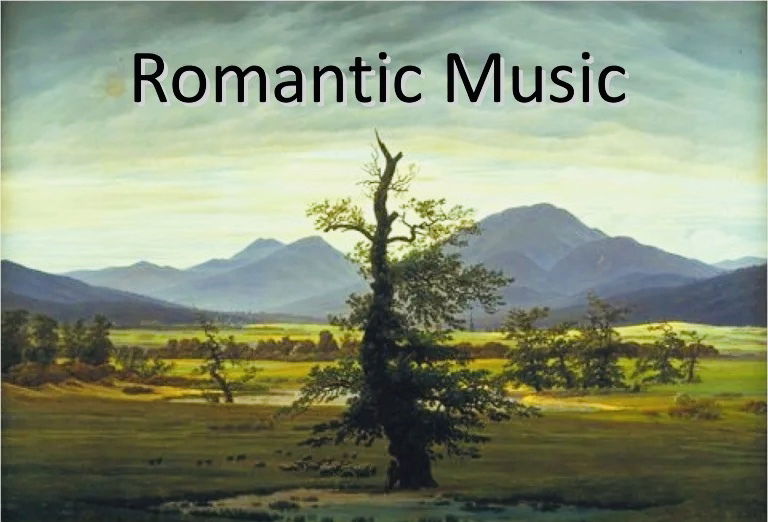Musical Romanticism

“The mind is wrong, the feeling never”
Rober Schumann.
Zweig was right: Europe has not seen such a wonderful generation as romantics since the Renaissance. Marvelous images of the world of dreams, naked feelings and the desire for sublime spirituality - these are the colors that paint the musical culture of romanticism.
THE EMERGENCE OF ROMANTICISM AND ITS AESTHETICS While the industrial revolution was taking place in Europe, the hopes placed on the Great French Revolution were crushed in the hearts of Europeans. The cult of reason, proclaimed by the Age of Enlightenment, was overthrown. The cult of feelings and the natural principle in man ascended the pedestal. This is how romanticism was born. In musical culture, it lasted a little more than a century (1800-1910), while in related areas (painting and literature), its term expired half a century earlier. Perhaps music is to blame for this - it was she who was at the top among the arts of the romantics as the most spiritual and freest of the arts. However, the romantics, unlike representatives of the eras of antiquity and classicism, did not build a hierarchy of arts with its clear division into types and genres . The romantic system was universal, the arts could freely move into each other. The idea of the synthesis of arts was one of the key ideas in the musical culture of romanticism. This relationship also applied to the categories of aesthetics: the beautiful was connected with the ugly, the high with the base, the tragic with the comic. Such transitions were connected by romantic irony, which also reflected the universal picture of the world. Everything that had to do with beauty acquired a new meaning among the romantics. Nature became an object of worship, the artist was idolized as the highest of mortals, and feelings were exalted over reason. Spiritless reality was opposed to a dream, beautiful, but unattainable. A romantic, with the help of imagination, built his new world, unlike other realities.
WHAT THEMES DID THE ROMANTIC ARTISTS CHOOSE?
The interests of the romantics were clearly manifested in the choice of themes they chose in art.
The theme of loneliness .
An underestimated genius or a lonely person in society - these themes were the main ones for the composers of this era (Schumann's "Love of the Poet", Mussorgsky's "Without the Sun").
The theme of "lyrical confession" .
In many opuses of romantic composers there is a touch of autobiography (Schumann's Carnival, Berlioz's Fantastic Symphony). Love theme . This is mainly the theme of unrequited or tragic love, but not necessarily (“Love and Life of a Woman” by Schumann, “Romeo and Juliet” by Tchaikovsky).
Path theme .
It is also called the theme of wandering . The soul of romance, torn apart by contradictions, was looking for its own path (“Harold in Italy” by Berlioz, “Years of Wanderings” by Liszt). The theme of death . Basically it was spiritual death (Tchaikovsky's Sixth Symphony, Schubert's "Winter Journey").
Nature theme .
Nature in the eyes of a romantic and a protective mother, and an empathetic friend, and punishing fate ("The Hebrides" by Mendelssohn, "In Central Asia" by Borodin). The cult of the native land (polonaises and ballads of Chopin) is also connected with this theme.
Fantasy theme
. The imaginary world for the romantics was much richer than the real one ("The Magic Shooter" by Weber, "Sadko" by Rimsky-Korsakov).
MUSICAL GENRES OF THE ROMANTIC ERA
The musical culture of romanticism gave impetus to the development of the genres of chamber vocal lyrics: the ballad (Schubert's The Forest King), the poem (Schubert's The Lady of the Lake) and songs , often combined into cycles (Schumann's Myrtle). The romantic opera was distinguished not only by the fantastic plot, but also by the strong connection between words, music and stage action. The opera is being symphonized. Suffice it to recall Wagner's "Ring of the Nibelungen" with a developed network of leitmotifs. Among the instrumental genres of romance, a piano miniature is singled out. To convey one image or a momentary mood, a small play is enough for them. Despite its scale, the play is full of expression. It can be a “song without words” (as in Mendelssohn), a mazurka, a waltz, a nocturne, or pieces with programmatic names (“Schumann’s Impulse”). Like songs, plays are sometimes combined into cycles (“Butterflies” by Schumann). At the same time, parts of the cycle, brightly contrasting, always formed a single composition due to musical connections. Romantics loved program music that combined it with literature, painting, or other arts. Therefore, the plot in their writings often controlled the form . There were one-movement sonatas (Liszt's B minor sonata), one-movement concertos (Liszt's First Piano Concerto), and symphonic poems (Liszt's Preludes), a five-part symphony (Berlioz's Fantastic Symphony).
MUSICAL LANGUAGE OF ROMANTIC COMPOSERS
The synthesis of the arts, sung by the romantics, influenced the means of musical expression. The melody has become more individual, sensitive to the poetics of the word, and the accompaniment has ceased to be neutral and typical in texture. Harmony was enriched with unprecedented colors to tell about the experiences of the romantic hero. Thus, the romantic intonations of languor perfectly conveyed altered harmonies that increase tension. Romantics also loved the effect of chiaroscuro, when the major was replaced by the minor of the same name, and the chords of the side steps, and the beautiful juxtaposition of keys. New effects were also found in natural modes , especially when it was necessary to convey the folk spirit or fantastic images in music. In general, the melody of the Romantics strove for continuity of development, rejected any automatic repetition, avoided the regularity of accents and breathed expressiveness in each of its motives. And texture has become such an important link that its role is comparable to that of melody. Listen to what a wonderful mazurka Chopin has!
INSTEAD OF A CONCLUSION
The musical culture of romanticism at the turn of the 19th and 20th centuries experienced the first signs of a crisis. The "free" musical form began to disintegrate, harmony prevailed over the melody, the elevated feelings of the romantic soul gave way to painful fear and base passions. These destructive tendencies brought romanticism to an end and opened the way for modernism. But, having ended as a trend, romanticism continued to live both in the music of the 20th century and in the music of the current century in its various components.
Blok was right when he said that romanticism arises "in all epochs of human life."
https://music--education-ru.translate.goog/muzykalnaya-kultura-romantizma-e-stetika-temy-zhanry-i-muzy-kal-ny-j-yazy-k/?_x_tr_sl=ru&_x_tr_tl=en&_x_tr_hl=en&_x_tr_pto=sc
